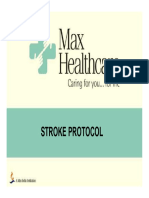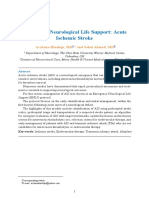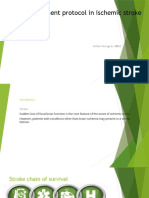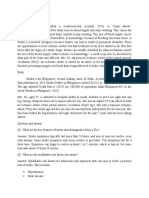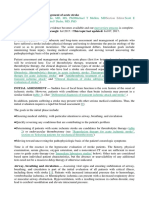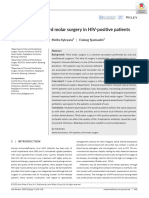Ischemic Stroke Management
Ischemic Stroke Management
Uploaded by
Ba LitCopyright:
Available Formats
Ischemic Stroke Management
Ischemic Stroke Management
Uploaded by
Ba LitOriginal Description:
Copyright
Available Formats
Share this document
Did you find this document useful?
Is this content inappropriate?
Copyright:
Available Formats
Ischemic Stroke Management
Ischemic Stroke Management
Uploaded by
Ba LitCopyright:
Available Formats
NURSING CARE TITLE:
STROKE (ISCHEMIC) MANAGEMENT PROTOCOL
ISCHEMIC STROKE MANAGEMENT: PROTOCOL & GUIDELINES
PURPOSE: To outline the nursing management of patients with a new diagnosis of stroke, R/O stroke, or TIA (Transient Ischemic Attack). LEVEL: Interdependent (A physicians order is required to execute all * items). SUPPORTIVE DATA: Stroke is the third leading cause of death in the US, the leading cause of brain injury in adults, and the leading cause of major disability. The effectiveness of organized stroke care in reducing mortality, institutionalization, and dependency in activities of daily living has been clearly shown. Organized stroke care is intended to facilitate the use of our best resources to minimize or prevent, when possible, the complications of a stroke through rapid identification of symptoms, appropriate interventions, and patient education. There are 4 classes of stroke. Two (2) are caused by clots (ischemic stroke) and 2 by hemorrhage (hemorrhagic stroke): Ischemic strokes are caused by blood clots, such as: 1. Cerebral thrombosis 2. Cerebral embolism Hemorrhagic strokes are caused by ruptured blood vessels, such as: 1. Intracerebral hemorrhage 2. Subarachnoid hemorrhage Note: 70-80% of all strokes are ischemic; ischemic strokes are the only type that may receive fibrinolytics (tPA) if the patient meets the criteria. The National Institute of Health Stroke Scale (NIHSS) is considered the standard, routine in-hospital measure of neurologic function (Attachment A). SCOPE OF PRACTICE: Independent. A Registered Nurse initiates and oversees this protocol. Some specific functions may be delegated to LPNs & NAs according to their scope of practice. ASSESSMENT AND CARE 1. Symptoms of stroke include: sudden numbness or weakness of the face, arm or leg; sudden confusion, trouble speaking or understanding; sudden trouble seeing in one or both eyes; sudden trouble walking, loss of balance or coordination and dizziness; and sudden severe headache.
2. Complete the NIHSS on all patients with the diagnosis of acute Stroke, r/o Stroke or TIA. It
should be performed q 2-4 hrs. (*) or as ordered for 24 hrs. (Attachment A).
3. Obtain vital signs (including MAP-Mean Arterial Pressure) and pulse oximetry
measurements every 2-4 hrs. (*) or as ordered for 24 hours on all patients with a diagnosis of acute stroke, R/O Stroke, or TIA. Note: Mean Arterial Pressure (MAP) = 2DBP + SBP 3
NURSING CARE
STROKE (ISCHEMIC) MANAGEMENT PROTOCOL
Diastole counts twice as much as systole because 2/3 of the cardiac cycle is spent in diastole. Usual range of MAP = 70 to 100mmHg. A MAP of 60 mmHg is necessary to perfuse the heart, brain and kidneys. 4. Document baseline data on the NIH Stroke Scale template in CPRS or VA Form #516-118312 in case of contingency. 5. If patient cannot cooperate for NIHSS evaluation, assess and document level of consciousness, random movements, response to stimuli, eye contact, and speech.
6. All patients admitted with a diagnosis of acute stroke, R/O stroke, TIA will be placed on the
remote monitor for 24 hours. If no order has been received within 24 hours, consult the physician to obtain a continue or discontinue monitoring order. 7. Please refer to the Nursing Protocol on Remote Cardiac Monitoring for specific guidelines. 8. Assess swallowing reflex before allowing patient to eat or drink. 9. When a patient with new stroke symptoms presents to an area where nurses are not trained to perform the NIHSS, consult nurses on Neurology Unit, Unit 5A. STANDARD OF CARE GUIDELINES: Recommended by the American Heart Association/American Stroke Association and Current Research Findings:
1. Patients who present within 48 to 72hrs from symptom onset of stroke need NIHSS, vital
signs (including MAP), and pulse oximetry completed every 2 hrs for the first 24 hrs, every 4 hrs for the next 24hrs and then q shift: Note: Physician orders should be obtained to verify the frequency required.
2. All patients must have at least one IV access site in the non-paralytic side. 3. Patients should have adequate hydration. IV fluid of D5W NSS at 80cc/hr is recommended
(*).
4. Increasing IV flow rate is the recommended intervention if MAP decreases more than 15%
below baseline MAP (*).
5. Hypertension is not routinely treated in patients with acute Ischemic Stroke. Treatment is
recommended (*) for fibrinolytic candidates, and patients with specific medical indications such as: AMI, aortic dissection, severe left ventricular failure, true hypertensive encephalopathy, and severe hypertension (SBP > 220 , DBP> 120 , MAP > 130mmHg). 6. Monitor the blood pressure closely especially if medications are administered because lowering a blood pressure too quickly can actually facilitate or extend a stroke. 7. Check for urinary retention with a bladder scan at least once within first 24 hrs.
8. Administer stool softeners and/or laxatives (*) if needed to prevent impaction.
NURSING CARE
STROKE (ISCHEMIC) MANAGEMENT PROTOCOL
9. Physical therapy needs be initiated (*) as soon as the patient is stable. Bedside therapy can be
arranged if the patient is unable to travel to the physical therapy department.
10. Activity needs to be advanced as tolerated (*). Avoid immobility. Use a wheelchair instead of
a Geri chair to promote muscle strengthening.
11. Apply knee high Ted hose (*) for patients with impaired mobility. (Be cognizant of DVT
prophylaxis).
12. Medications (*) for patients with Ischemic Stroke to include an antiplatelet or an
anticoagulant agent. However, all anticoagulants and antiplatelets must be held for the first 24 hours after a patient receives tPA. Note: If the patient is ordered a Heparin drip, never bolus the patient. Cardiac and Pulmonary weight-based heparin protocols should not be used because of bolusing. 13. Initiate the Pressure Ulcer Prevention and General Skin Care Protocol, Immobility Management Protocol, and the Fall Prevention and Management Protocol. REPORTABLE CONDITIONS: Alert Neurologist/designee (on-call attending) for the following conditions:
1. MAP decreases more than 15% from the baseline MAP for the first three days after a Stroke
2. 3. 4. 5. 6. or TIA. Neurological changes (note if changes occur concomitantly with change in BP). Sustained headache unrelieved by prescribed medication. Oral temperature exceeding 101 degrees. Pulse oximetry measurement less than 89%. Seizure activity
PATIENT/SIGNIFICANT OTHER INSTRUCTION/EDUCATION: 1. Arrange for patient/family to view Stroke videos on Osbourne system. 2. Give patient/family appropriate educational brochures. Provide explanations as needed. 3. Initiate Stroke Education referral. DOCUMENTATION: Document the following in the patients medical record: 1. 2. 3. 4. Assessment findings Care/education provided. Patient response to care/.education. Initiate/evaluate/revise Plan of Care.
REFERENCES: Adams, H. (1998). Management of Stroke (first edition).
NURSING CARE
STROKE (ISCHEMIC) MANAGEMENT PROTOCOL
American Heart Association. (2001). ACLS Provider Manual. AHA. American Heart Association. (1996). Guidelines for the Management of Patients with Acute Ischemic Stroke. AHA. American Heart Association. (1999). Guidelines for Thrombolytic Therapy for Acute Stroke. AHA. American Stroke Association. (1999). Management of Transient Ischemic Attacks. ASA. American Stroke Association. (1999). Preventing Ischemic Stroke in Patients with Prior Stroke and Transient Ischemic Attack. ASA. Dalen, J. (Ed.). (1998). The fifth ACCP consensus conference on antithrombotic therapy. Chest, 114 (5), 693-695 Supplement. Kalra, Lalit, Evans, & Andrew. (2000). Alternative strategies for stroke care: A prospective randomized controlled trial. The Lancet, 356, 894-899. Kothari, R. (Ed). (2000). Emergency Stroke Care Task Force Acute Stroke Care. American Heart Association. RESCISSIONS: None AUTOMATIC RESCISSION DATE: January 2012 APPROVAL: Signature on file ________________________________ Joy Easterly, RN, MHCA Associate Director, Patient/Nursing Services 2/21/07 _______________ Date
Distribution:
All patient care areas where nursing care is provided.
Prepared by: Patricia Langhans, RN, MSN Cheryl Howard, RN, MS, CCRN Sally B. Zachariah, MD, Chief of Neurology
NURSING CARE
STROKE (ISCHEMIC) MANAGEMENT PROTOCOL Appendix A
NURSING CARE
STROKE (ISCHEMIC) MANAGEMENT PROTOCOL
NURSING CARE
STROKE (ISCHEMIC) MANAGEMENT PROTOCOL
NURSING CARE
STROKE (ISCHEMIC) MANAGEMENT PROTOCOL
You might also like
- CPH Medtech TransesDocument10 pagesCPH Medtech TransesBea Janelle E. AfallaNo ratings yet
- Physical Education and Health 2Document11 pagesPhysical Education and Health 2Hazel EncarnacionNo ratings yet
- Adult Health Section Nclex QuestionsDocument296 pagesAdult Health Section Nclex QuestionsJohn Desir50% (2)
- Tve 12 - Beauty Care 1ST Semester Finals Module 7 (Dela Cruz)Document16 pagesTve 12 - Beauty Care 1ST Semester Finals Module 7 (Dela Cruz)Aneza Jane Juanes100% (2)
- Peri-Arrest Arrhythmias: AuthorsDocument11 pagesPeri-Arrest Arrhythmias: AuthorsMohammadAbdurRahmanNo ratings yet
- Activating A Stroke Alert - A Neurological Emergency - CE591Document7 pagesActivating A Stroke Alert - A Neurological Emergency - CE591Czar Julius Malasaga100% (1)
- Purpose: CVA (Stroke) Patients (Ischemic and Hemorrhagic), Management ofDocument4 pagesPurpose: CVA (Stroke) Patients (Ischemic and Hemorrhagic), Management ofRoxanne AlvarezNo ratings yet
- Cardio Pulmonary ResuscitationDocument12 pagesCardio Pulmonary Resuscitationalpana.rajput87No ratings yet
- ACLS II Sept 25 StudentsDocument60 pagesACLS II Sept 25 StudentsLex CatNo ratings yet
- StrokeDocument49 pagesStrokeChellamani UmakanthanNo ratings yet
- DCV PDFDocument25 pagesDCV PDFLeyDi CamposanoNo ratings yet
- Special Circumstances GuidelinesDocument19 pagesSpecial Circumstances GuidelinesRayNo ratings yet
- Special Circumstances Guidelines ALSDocument19 pagesSpecial Circumstances Guidelines ALSHamzaMasoodNo ratings yet
- Nursing Pivotal Role in StrokeDocument24 pagesNursing Pivotal Role in StrokeSAHIL PAREKHNo ratings yet
- Module 1 - Acute Ischemic StrokeDocument51 pagesModule 1 - Acute Ischemic StrokeRick RanitNo ratings yet
- Acute MX of StrokeDocument23 pagesAcute MX of StrokeAshish GuragainNo ratings yet
- StrokeDocument2 pagesStrokeayen_castillonNo ratings yet
- Case StudyDocument34 pagesCase StudyBSNNursing101No ratings yet
- Cardiac Arrest1Document27 pagesCardiac Arrest1Muhammad HaekalNo ratings yet
- 3390-Article Text-1555-3802-10-20200606Document12 pages3390-Article Text-1555-3802-10-20200606Mayara Bongestab ParteliNo ratings yet
- MOH Pocket Manual in Emergency MedicineDocument244 pagesMOH Pocket Manual in Emergency MedicineAli Al-Brahim (AlucardAli)No ratings yet
- Lesson No 2 Stroke - BSN IVA BSN IVBDocument13 pagesLesson No 2 Stroke - BSN IVA BSN IVBMary Grace GestiadaNo ratings yet
- ACLS Presentation 3.8.22Document33 pagesACLS Presentation 3.8.22OLOWO SAMUELNo ratings yet
- Acls Study Guide 2016 For Pulse 2016Document8 pagesAcls Study Guide 2016 For Pulse 2016eng78ineNo ratings yet
- Management of Medically Compromised PatientsDocument32 pagesManagement of Medically Compromised PatientssnigxrtNo ratings yet
- Managing Atrial Fibrillation 2015Document8 pagesManaging Atrial Fibrillation 2015Mayra Alejandra Prada SerranoNo ratings yet
- Clin Cardiology CasesDocument34 pagesClin Cardiology CasesSunny Singh0% (1)
- CULLA - CASE-VIGNETTE-ANALYSIS StrokeDocument4 pagesCULLA - CASE-VIGNETTE-ANALYSIS StrokeSheenaGuinoCullaNo ratings yet
- Guidelines For The Management of Acute Stroke: Emergency DepartmentDocument10 pagesGuidelines For The Management of Acute Stroke: Emergency DepartmentUhuebor DavidNo ratings yet
- Acute Ischaemic StrokeDocument40 pagesAcute Ischaemic StrokeDana Crusoveanu100% (1)
- 1arrhythmia 2023-Lec22 Part2 - 231216 - 132349Document8 pages1arrhythmia 2023-Lec22 Part2 - 231216 - 132349ali.j.alhassaniNo ratings yet
- SP50 Cardiac Stress-Exercise Testing (Adult, Peds)Document8 pagesSP50 Cardiac Stress-Exercise Testing (Adult, Peds)Sonu JacobNo ratings yet
- Guidelines & Protocols: Stroke and Transient Ischemic Attack - Management and Prevention Advisory CommitteeDocument13 pagesGuidelines & Protocols: Stroke and Transient Ischemic Attack - Management and Prevention Advisory CommitteeAndi SaputraNo ratings yet
- Cardiac SurgeryDocument19 pagesCardiac SurgerySimon JosanNo ratings yet
- Acute Ischemic Stroke: Nursing's Pivotal RoleDocument34 pagesAcute Ischemic Stroke: Nursing's Pivotal RoleabolojeenNo ratings yet
- CPG - Unstable Angina-NSTEMIDocument62 pagesCPG - Unstable Angina-NSTEMIMohd RafiNo ratings yet
- Ischemic Stroke Management by The Nurse PR - 2019 - The Journal For Nurse PractDocument9 pagesIschemic Stroke Management by The Nurse PR - 2019 - The Journal For Nurse PractLina SafitriNo ratings yet
- KillipsDocument12 pagesKillipsNhorlyn Adante SoltesNo ratings yet
- National Stroke Thrombolysis Guideline Template v9 5-12-13 FINAL 2Document15 pagesNational Stroke Thrombolysis Guideline Template v9 5-12-13 FINAL 2Muhammad FauziNo ratings yet
- 2014 February ALS Cardiac Arrest and ROSCDocument37 pages2014 February ALS Cardiac Arrest and ROSCAuliaFadhilahTasruddinNo ratings yet
- Cardiac Dysrhythmia Case StudyDocument6 pagesCardiac Dysrhythmia Case StudyCharlyn JenselNo ratings yet
- Acute Heart Failure Diagnosing and Managing Acute Heart Failure in Adults.Document21 pagesAcute Heart Failure Diagnosing and Managing Acute Heart Failure in Adults.Madalina TalpauNo ratings yet
- The Management of Patients With Acute Myocardial Infarction: Pocket GuidelinesDocument21 pagesThe Management of Patients With Acute Myocardial Infarction: Pocket GuidelinesRubelyn Joy LazarteNo ratings yet
- 19 Stroke..Document96 pages19 Stroke..Thanery Chiri ZegarraNo ratings yet
- Current Clinical Strategies: Handbook of AnesthesiologyDocument180 pagesCurrent Clinical Strategies: Handbook of AnesthesiologydramaganaNo ratings yet
- Summary of 2016 Esc Guidelines On Heart Failure, Atrial Fibrillation, Dyslipidaemia and Cardiovascular PreventionDocument11 pagesSummary of 2016 Esc Guidelines On Heart Failure, Atrial Fibrillation, Dyslipidaemia and Cardiovascular PreventionNick StamatiadisNo ratings yet
- Adult Advanced Life Support GuidelinesDocument11 pagesAdult Advanced Life Support Guidelinesrutba.ahmkhanNo ratings yet
- Acute Coronary Syndrome (ACS) : Basic Principles For ACSDocument4 pagesAcute Coronary Syndrome (ACS) : Basic Principles For ACSRendra DananjayaNo ratings yet
- Stroke Clinical PathwayDocument35 pagesStroke Clinical PathwayLaurencia Leny100% (2)
- Adult Advanced Life Support GuidelinesDocument11 pagesAdult Advanced Life Support GuidelinesDellaneira SetjiadiNo ratings yet
- Management of Acute Ischemic Stroke (AIS) DR GaneshDocument69 pagesManagement of Acute Ischemic Stroke (AIS) DR GaneshDr Ganeshgouda MajigoudraNo ratings yet
- ReviewerDocument14 pagesReviewertinrojasNo ratings yet
- Acv Manejo Up To DayDocument21 pagesAcv Manejo Up To DayDaniel RodríguezNo ratings yet
- SG001 - Jore, Julianna RheavenDocument9 pagesSG001 - Jore, Julianna RheavenJulianna Rheaven JoreNo ratings yet
- Medical Emergency Oral Q.docx26.docx8Document44 pagesMedical Emergency Oral Q.docx26.docx8Simina ÎntunericNo ratings yet
- Harmony of the Heart: A Comprehensive Exploration of Atrial TachycardiaFrom EverandHarmony of the Heart: A Comprehensive Exploration of Atrial TachycardiaNo ratings yet
- Immediate Life Support for healthcare Practitioners: A Step-By-Step GuideFrom EverandImmediate Life Support for healthcare Practitioners: A Step-By-Step GuideNo ratings yet
- Forgive MeDocument1 pageForgive MeBa LitNo ratings yet
- Airborne PrecautionDocument6 pagesAirborne PrecautionBa LitNo ratings yet
- AND LET GO: HyskalDocument5 pagesAND LET GO: HyskalBa LitNo ratings yet
- Creamy Strawberry-Lemon SquaresDocument1 pageCreamy Strawberry-Lemon SquaresBa LitNo ratings yet
- Cosyntropin ( - Koe Sin TROE Pin) (Cortrosyn) : Given To Control Symptoms Such As Diarrhea or FlushingDocument2 pagesCosyntropin ( - Koe Sin TROE Pin) (Cortrosyn) : Given To Control Symptoms Such As Diarrhea or FlushingBa LitNo ratings yet
- EOL PaperDocument1 pageEOL PaperBa LitNo ratings yet
- Chapter 30Document16 pagesChapter 30Ba LitNo ratings yet
- Pulseless VT/VF Algorithm First Impression: Sick or Not Sick? Primary SurveyDocument9 pagesPulseless VT/VF Algorithm First Impression: Sick or Not Sick? Primary SurveyBa LitNo ratings yet
- Burns Key Pts Chapter - 025Document4 pagesBurns Key Pts Chapter - 025Ba LitNo ratings yet
- Dosage Calc Review Packet BlankDocument9 pagesDosage Calc Review Packet BlankBa LitNo ratings yet
- Case Study (Case Study of Lulu M.) I. Early DevelopmentDocument3 pagesCase Study (Case Study of Lulu M.) I. Early DevelopmentLovely Mae GalosNo ratings yet
- NCM - 107b - Application of Nursing Theory in A Given Scenario - Maltezo, RuizDocument5 pagesNCM - 107b - Application of Nursing Theory in A Given Scenario - Maltezo, RuizPatricia Dianne RuizNo ratings yet
- Disaster AwarenessDocument9 pagesDisaster AwarenessZukya RonaNo ratings yet
- Behavioral Sciences and Ethics BSE101 Course Syllabus (Spring 2024) New For MD StudentsDocument28 pagesBehavioral Sciences and Ethics BSE101 Course Syllabus (Spring 2024) New For MD Students350705224No ratings yet
- RiccaDocument4 pagesRiccastanleyNo ratings yet
- Trauma Rana GreeneDocument29 pagesTrauma Rana GreeneGG INo ratings yet
- Extraction ForcepsDocument3 pagesExtraction ForcepsShift UallNo ratings yet
- Case Study Project: IMPACT of Covid-19 On TATA MotorsDocument17 pagesCase Study Project: IMPACT of Covid-19 On TATA MotorsAlwala Sai CharanNo ratings yet
- Management of Third Molar Surgery in HIV Positive PatientsDocument4 pagesManagement of Third Molar Surgery in HIV Positive Patientskiara wardanaNo ratings yet
- SITXWHS007 Risk Management Plan TemplateDocument5 pagesSITXWHS007 Risk Management Plan Templatehelpdeskarea001No ratings yet
- Care Plan PostpartumDocument2 pagesCare Plan Postpartumteokie082483% (6)
- Matematik Tg5 - Bab 3Document14 pagesMatematik Tg5 - Bab 3LoveableNo ratings yet
- Biology Blue Printii Pu 2023 - 2024Document2 pagesBiology Blue Printii Pu 2023 - 2024Pratham 105No ratings yet
- Amino Acids ProductionDocument8 pagesAmino Acids ProductionJamie SamuelNo ratings yet
- DLP15 Pe6Document2 pagesDLP15 Pe6Aileen DesamparadoNo ratings yet
- Chapter 1: Introduction To PsychologyDocument5 pagesChapter 1: Introduction To PsychologyJackNo ratings yet
- Sartika Rini Hayatii,+naskah+235Document15 pagesSartika Rini Hayatii,+naskah+235rahma nidaNo ratings yet
- Westmed Syringe BrochureDocument2 pagesWestmed Syringe BrochureterengganubloodgasNo ratings yet
- Logistics Management Midterm Quiz 1Document3 pagesLogistics Management Midterm Quiz 1Santi SeguinNo ratings yet
- Ergonomic Definition PDFDocument2 pagesErgonomic Definition PDFLaraNo ratings yet
- SP 23 Unit 2.4 PortfolioDocument13 pagesSP 23 Unit 2.4 PortfolioAnahi ByersNo ratings yet
- oxygen concentrator for covid patients Oxygen concentrator घर के लिए खरीद रहें हैं अगर ऑक्सीजन कंसंट्रेटर, तो जरूर रखें इन 7 बातों का ध्यान - if you are planning to buy an oxygen concentrator for hombharDocument19 pagesoxygen concentrator for covid patients Oxygen concentrator घर के लिए खरीद रहें हैं अगर ऑक्सीजन कंसंट्रेटर, तो जरूर रखें इन 7 बातों का ध्यान - if you are planning to buy an oxygen concentrator for hombharpuneetNo ratings yet
- NSG 129: Nursing Leadership and ManagementDocument13 pagesNSG 129: Nursing Leadership and ManagementJOHN PEARL FERNANDEZ100% (1)
- IiedDocument94 pagesIiedrexyben tuvieraNo ratings yet
- Starkville Dispatch Eedition 12-30-20Document16 pagesStarkville Dispatch Eedition 12-30-20The DispatchNo ratings yet
- TLE HE NC7 - 8 w1 8Document26 pagesTLE HE NC7 - 8 w1 8Melanie AlidoNo ratings yet
- Department of Education: Annual Gender and Development (Gad) Plan and Budget Accomplishment ReportDocument2 pagesDepartment of Education: Annual Gender and Development (Gad) Plan and Budget Accomplishment Reportmrscientifico ngpkmNo ratings yet










